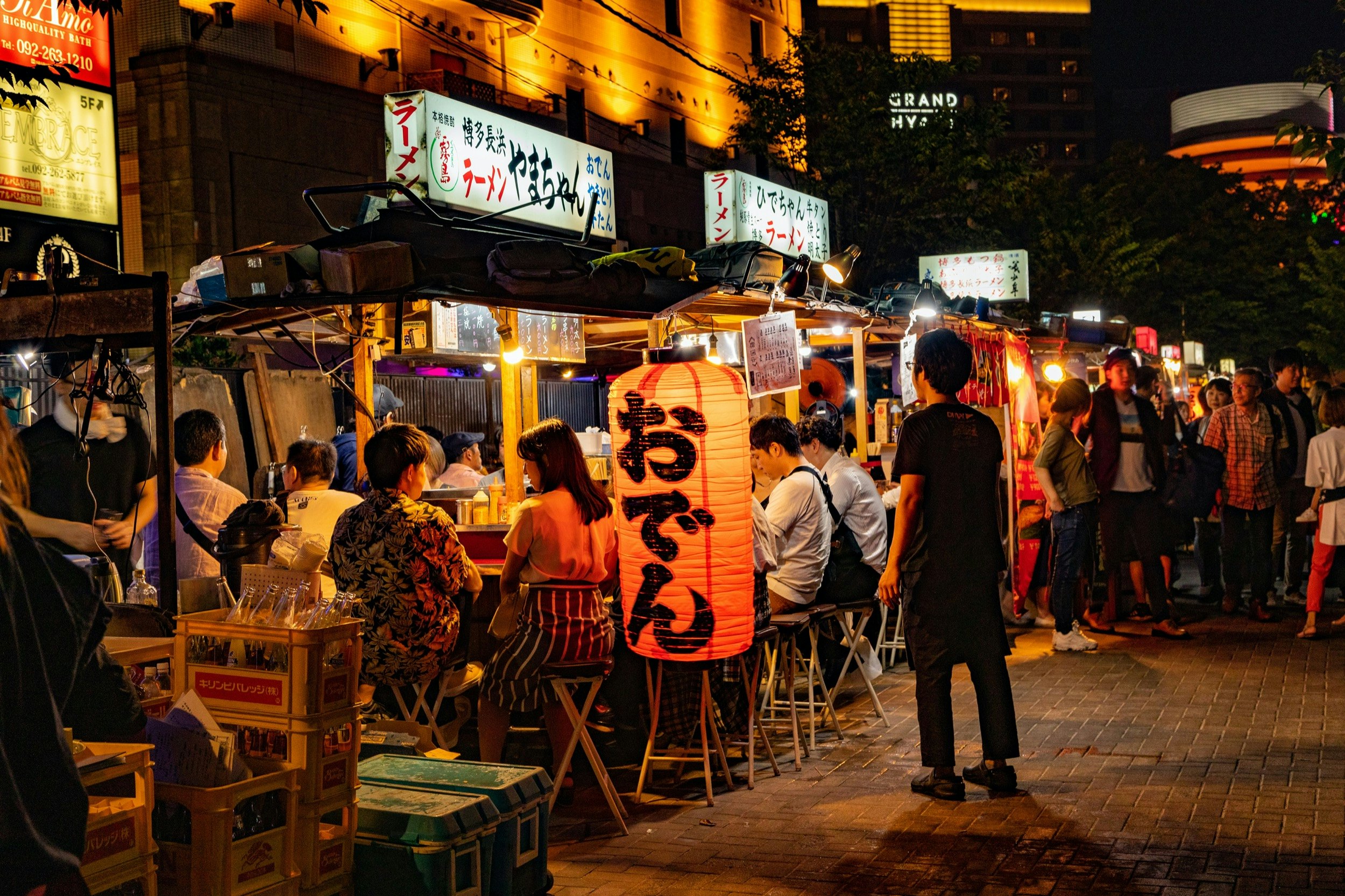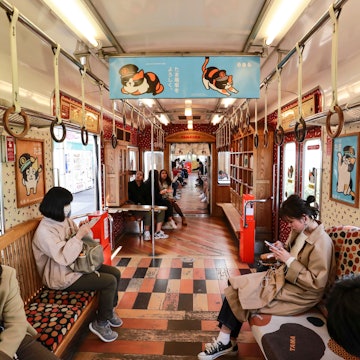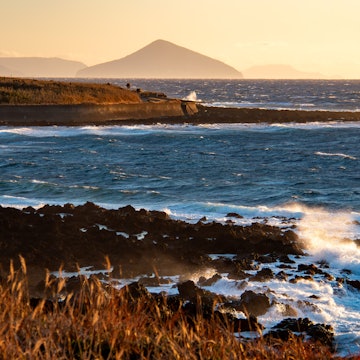
Delicious, luxurious, unusual: Kyushu is one-of-a-kind
Sponsored by
Mar 30, 2021 • 7 min read

The roof structure at the Roumon Tower gate at Takeo Onsen has a surprising secret connecting it to Tokyo Station © iamlukyeee / Shutterstock
The island of Kyushu, the southern- and westernmost main island of Japan, has a personality all its own:
As the historic gateway to mainland Asia and Europe, culinary staples and practices that are now commonplace in Japan first entered this country through the ports of Hirado and Nagasaki.
With its active volcanoes, the island is home to some of Japan’s most famous onsen (hot springs) resorts. And sumptuous ryokans (traditional Japanese inns) across the island each have a distinct style.
Even more fascinating, there’s wonder waiting around every corner – from secret zodiac symbols to a surprisingly cutting-edge library.
So, if you’re exploring this unique region, here’s a few of our favorite places that make Kyushu perfect for whatever one-of-a-kind experience you’re looking for.

Fukuoka Prefecture
Tasty: Yatai food carts for a city on the move
The city of Fukuoka – the largest on the island – is Japan’s up-and-coming destination for tech start-ups and other innovators, and it has a fantastic food scene to match. Visit its Tenjin and Nagahama neighborhoods to sit at one of more than 100 yatai food carts, more than the rest of Japan combined, for the best cooking and companionship.
Fukuokans and non-Fukuokans alike particularly salivate at the mention of Hakata ramen. The distinctive local version of these ubiquitous noodles is called tonkotsu rāmen, served in a hearty broth made from pork bones stewed for a day or more.
Tasty: Itoshima seafood and seasoning
Itoshima, famous for its beaches, is popular among summer vacationers, but it is quickly gaining a reputation as a foodie destination year-round. Don’t miss Tokuei Maru, a local oyster hut serving the freshest possible seafood. Located in a shoreline row of restaurants, boats literally pull up to the back door to deliver the daily catch. This self-service oyster/seafood grilling experience is available during the winter season from November through March.
Another hot attraction is Kobo Tottan’s Mataichi no Shio, which makes artisanal salt containing rich minerals from the mountains and sea of the Itoshima Peninsula. One of its most popular items is caramel pudding with a sprinkling of salt on top – get there early for your share of the good stuff!
Lavish: Seaside views and food at Sangaono-Isshuan
To get the full Itoshima experience you’ll want iconic accomodations in addition to excellent cuisine. Sangaono-Isshuan, a traditional Japanese inn, boasts a commanding view of the Genkainada Sea. Elegant rooms emphasize wafu (Japanese) style, with tatami mats and futons (instead of beds), and private open-air baths can be reserved.
The inn’s seasonal cuisine takes full advantage of local specialties including Itoshima beef and seafood. Meals are served on private terraces with ocean views.

Saga Prefecture
Quirky: A new way to browse books, at Takeo City Library
Make sure to visit Takeo City’s one-of-a-kind library which is attracting a lot of attention. The first thing that hits visitors who step into this establishment is the smell of fresh coffee – a Starbucks café and attached bookstore at the heart of the library transformed an already unique space into a conceptually compelling experiment.
Built in 2000 and completely renovated in 2013, over a million people visit the Takeo City Library each year, even though only 49,000 people live in the city. There is an enthusiastic energy about the place as the mix of commercial and public space really draws the crowds. This isn’t a stuffy city library from the past – it’s city library 2.0.
Quirky: A surprising find at Takeo Onsen
If you’ve ever traveled through Tokyo Station, you might have seen eight animals from the Chinese zodiac decorating the points of the station’s octagonal north dome. If so, did you ever wonder the other four symbols were?
When the station was undergoing renovations for its 100th anniversary, an effort was made to see if the other four animals could be located. Kingo Tatsuno, the famous architect of Tokyo Station from Saga Prefecture, had been working on other projects at the same time and inquiries were sent to all the other buildings he had designed.
It was here, at Takeo Hot Springs in his home prefecture, that the puzzle was finally completed. The four missing animals of the Chinese Zodiac were found hidden in the underside of the roof structure at the Roumon Tower gate. This mysterious relationship, where the signs in two buildings are combined to form the complete Chinese zodiac continues to fascinate to this day.

Quirky: Takeo Hot Springs and Moto-yu
Takeo Hot Springs, which has a history going back more than 1,300 years, is said to have refreshed the armies of Toyotomi Hideyoshi. The town's impressive, lacquered Chinese-style entrance gate, Sakura-mon, was astonishingly built without nails.
The area is also famous for Moto-yu the oldest Japanese hot spring facility building in use today (1876). It’s a simple, wooden hall but with its high ceilings and spacious bathtubs, the baths have a relaxed atmosphere and a touch of retro romance.

Lavish and Tasty: Taishoya Ryokan Hotel, Ureshino Onsen
Built around a hot spring with high sodium levels and said to have skin-nourishing properties, Taishoya Ryokan Hotel offers the ultimate in relaxation. The hotel itself was designed by one of Japan’s leading architects, and the many stunning water features in its sprawling gardens can be heard throughout the campus. With an onsite spa, three buildings with rooms appointed in different styles, and four deluxe private suites, this is as serene and luxurious as it comes.
Food presentation at Taishoya is also exquisite. This is kaiseki cuisine (a traditional Japanese multi-course meal) at its finest. Novice diners won’t know where to start or when it will end – just when it seems as if the end is near, even more food arrives at the table. In addition to premium beef and seafood courses, particularly popular is the locally produced tofu made from soybeans grown in the prefecture and paired with seasonal ingredients.

Kumamoto Prefecture
Lavish: Kurokawa Onsen, Kumamoto Prefecture
Kurokawa Onsen is one of Japan's most attractive hot spring towns, located on both sides of a steep gorge in the middle of Kyushu, about 12 miles north of Mount Aso. Safely secluded from the rest of the world, it's the perfect spot to experience what an onsen ryokan getaway is all about.
Favorite baths include Yamamizuki, Kurokawa-sō and Shimmei-kan, with cave baths and riverside rotemburo (Kurokawa is especially famous for its rotemburo, or a tour of outdoor baths). Many places offer konyoku (mixed bathing) alongside women-only baths.
While staying in Kurokawa, guests have access to the private baths at their ryokan, but both overnight visitors and day trippers can explore any other bath in town to enjoy Rotemburo Meguri. Purchase a wooden nyūtō tegata (onsen passport) for admission to up to three additional baths.
Lavish: Yuno Kura, Hirayama Onsen
Historic accommodations near Kumamoto don’t come any better or well-appointed than this. Yuno Kura caters to day-trippers and overnight customers alike and features a variety of rooms and villas for different tastes – some decked out in traditional Japanese and modern Japanese styles and with attached gardens or open-air baths. There’s also an on-site spa, featuring aromatherapy and reflexology treatments.
The waters of Hirayama Onsen, located between Yamaga and Mikawa-cho, have particularly high levels of sulfur. Over the centuries the springs have been reported to heal a variety of skin afflictions.

Oita Prefecture
Tasty: Yufuin Onsen, Oita Prefecture
The Oita region, which includes the world-famous onsen town of Beppu, is famous for tori-ten (chicken tempura), reimen (cold noodle soup) and the marinated-raw-fish dish known as Ryūkyū.
For the best of it all, check out Onjuku Yagura – a ryokan (Japanese inn) at Yufuin Onsen, that prides itself on its cuisine. Tasty morsels of the local chicken and tender, marbled Bungo beef are self-grilled at the table – a popular pastime in Japan and an experience you’ll recount for years. When you’re done eating, each room has a unique style with private open-air baths that face Yufuin Onsen and Mt. Yufu.
From extravagant onsen and accommodations, to remarkable fusion cuisine, to interesting local idiosyncrasies, Kyushu will always keep you guessing what unique experience is coming up next.
Sponsored by Kyushu Tourism Promotion Organization
As a travel entertainment and inspirational media outlet, we sometimes incorporate brand sponsors into our efforts. This activity is clearly labeled across our platforms.
This story was crafted collaboratively between Kyushu Tourism Promotion Organization and Lonely Planet. Both parties provided research and curated content to produce this story. We disclose when information isn’t ours.
With sponsored content, both Lonely Planet and our brand partners have specific responsibilities:
-
Brand partner
Determines the concept, provides briefing, research material, and may provide feedback.
-
Lonely Planet
We provide expertise, firsthand insights, and verify with third-party sources when needed.















